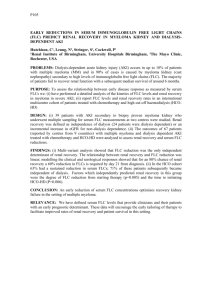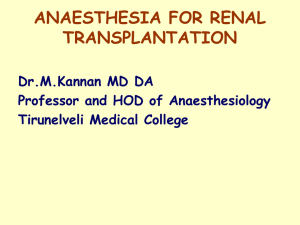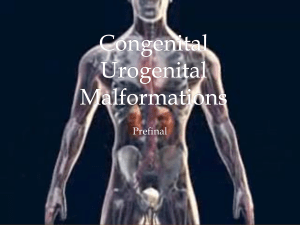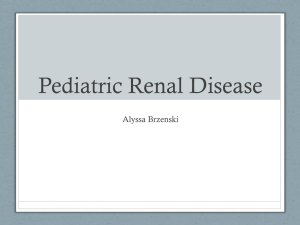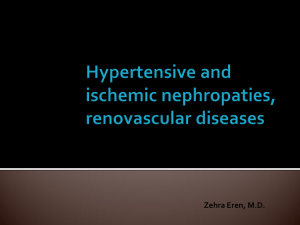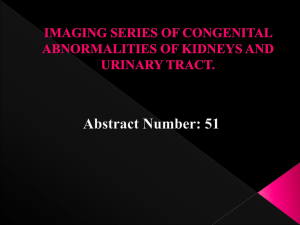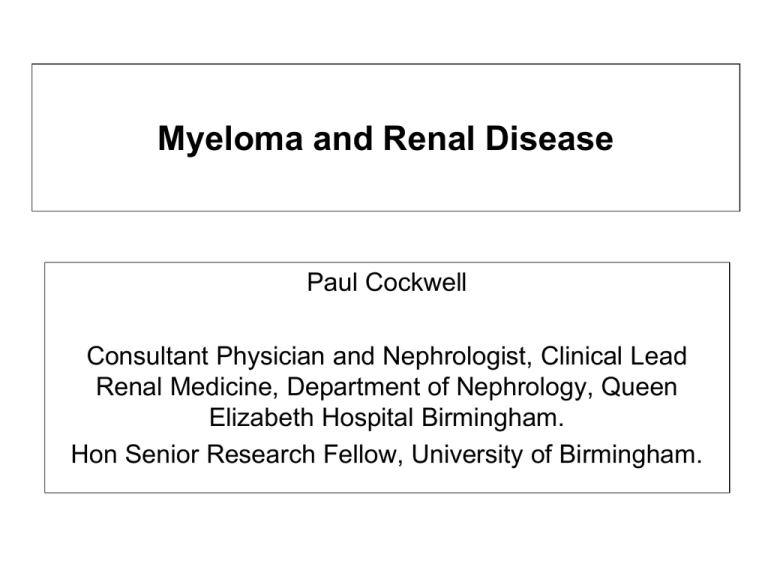
Myeloma and Renal Disease
Paul Cockwell
Consultant Physician and Nephrologist, Clinical Lead
Renal Medicine, Department of Nephrology, Queen
Elizabeth Hospital Birmingham.
Hon Senior Research Fellow, University of Birmingham.
The stages of Chronic Kidney Disease
Stage*
Description
eGFR
ml/min/
1.73m2
Prevalence
(%)
No in UBC
(estimate)
1
normal or increased
GFR with evidence of
kidney damage
>90
3.3
16,500
2
Maintained eGFR +
other evidence of kidney
damage
60-89
3.0
15,000
3A&B
Mild-moderate decrease
in GFR
30-59
4.5
22,500
4
Severe decrease in GFR
15-29
0.3
1,500
5
Kidney Failure
<15
0.15
750
Job bag number: 131/UK/11-01/NMAR/2727 Preparation date: January 2011
Calculating estimated GFR
• The different equations used for calculating estimated (e)GFR are
not equivalent
• aMDRD – current internationally accepted standard for reporting
kidney function when the eGFR is abnormal
– aMDRD factors 4 variables – age, sex, ethnicity and creatinine – to
provide an eGFR
• CG eGFR – the equation used in most drug dose adjustment
algorithms in renal disease
– CG and eGFR are not equivalent
aMDRD: abbreviated modification of diet in renal disease; CG: Cockcroft-Gault; (e)GFR: (estimated) glomerular filtration
3
Job bag number: 131/UK/11-01/NMAR/2727 Preparation date: January 2011
Acute Kidney Injury Network (AKIN) staging
Only one criterion is required to qualify for stage
Stage
Serum creatinine criteria
Urine output criteria
Stage 1
Increased serum creatinine of ≥0.3 mg/dL
(≥26.4 μmol/L) or ≥1.5-2 times from baseline
<0.5 mL/kg/ hour for >6 hours
Stage 2
Increased serum creatinine to ≥2-3 times from
baseline
<0.5 mL/kg/ hour for >12 hours
Stage 3
Increased serum creatinine to >3 times from
baseline
<0.3 mL/kg/ hour for 24 hours or
anuria for 12 hours
or ≥4.0 mg/dL (≥354 μmol/L) with an acute
increase of at least 0.5mg/dL (44 μmol/L)
or renal replacement therapy
4
Mehta RL et al. Crit Care 2007; 11: 1 – 8
Multiple myeloma
• Renal function a major determinant of
Morbidity/Mortality
• Around 50% have significant renal
impairment at presentation
– At new presentation around 4 pmp require
dialysis
– Myeloma and dialysis survival poor
Disease specific kidney injury in Myeloma
• Cast Nephropathy (Myeloma Kidney)
• Tubular epithelial cell injury +/- interstitial inflammation and fibrosis
• AL Amyloidosis
• Light Chain Deposition Disease
• Fibrillary GN
• Heavy Chain Deposition Disease
• Cryoglobulinaemic glomerulonephritis
Co-factors for Acute Kidney
Injury in Myeloma
• Drugs
– NSAIDS
– Diuretics
• Hypercalcaemia
• Sepsis
• Volume depletion/dehydration
• Operative stress
Disease specific kidney injury in Myeloma
• Cast Nephropathy (Myeloma Kidney)
• Tubular epithelial cell injury +/- interstitial inflammation
and fibrosis
• AL Amyloidosis
• Light Chain Deposition Disease
• Heavy Chain Deposition Disease
• Cryoglobulinaemic glomerulonephritis
Intact Ig and Ig Free light chain (FLC)
production by plasma cells
Kappa
- Monomeric
- 22.5 kd
- 40% renal clearance
- 2-3 hr serum half life
Lambda
- Dimeric
- 45 kd
- 20% renal clearance
- 4-6 hr serum half life
Normal range – serum FLC
Serum Lambda FLC (mg/L)
100000
10000
1000
100
10
1
0.1
0.1
1
10
100
1000
10000 100000
Serum Kappa FLC (mg/L)
Lancet 2003; 361: 489-491
Immunoglobulin FLC levels in myeloma
100000
l FLC (mg/L)
10000
Normal sera
Kappa BJ
1000
Lambda BJ
100
NSMM
10
1
0.1
0.1
1
10
100
1000
10000
100000
k FLC (mg/L)
Blood.2001: 97: 2900-02
Comprehensive Clinical Nephrology (Johnson & Feehally); p238
Rapid renal scarring in Myeloma Kidney
Repeat Biopsy
Presentation Biopsy
6 weeks
Basnayake et al: J Clin Path
NDT 2010: 25: 419-26
Severe AKI and myeloma is a
medical emergency
Approach to AKI and suspected
cast nephropathy
• Screen ASAP with SPE and sFLC or UPE
• Suspect cast nephropathy if sFLC>500mg/l
or UPE BJP+ve
• High quality supportive care
• Prompt commencement of chemotherapy
Supportive Care
• Optimise urine output
• Correct hypercalcaemia
• Correct acidosis
• Avoid diuretics
• Avoid nephrotoxic drugs
Chemotherapy
• Start ASAP
• Use dexamethasone and novel agents
• There is increasing experience in
bortezomib in severe renal failure
Early sFLC responses are a
major determinant of renal
recovery
Renal recovery from cast nephropathy and changes in
sFLC levels in the first 21 days
For an 80% chance
of renal recovery
there must be a 60%
reduction in sFLC
by day 21
39 patients with cast nephropathy: Birmingham + Mayo
What about extra-corporeal
removal of FLC?
Plasma exchange can remove
intravascular FLC
But does this translate into
clinical benefit??
Plasma Exchange When Myeloma Presents as Acute Renal Failure
A Randomized, Controlled Trial.
Clark et al: Ann Intern Med. 2005;143:777-784.
MERIT – primary end-point
(thanks to J Behrens and M Drayson)
Myeloma Load
- FLC generation
~15%
intravascular
extravascular
~ 85%
Does High Cut-Off (protein-permeable)
dialysis provide an alternative approach to
plasma exchange for the removal of FLC?
HCO Membrane - increased permeability for mid-molecules
Convective permeability
Gambro HCO 1100 –6 hour dialysis – FLC
removal kinetics – myeloma patient
800
Serum free lambda (mg/L)
9000
Serum free lambda
Dialysate free lambda
700
8000
600
7000
500
6000
5000
400
4000
300
3000
200
2000
100
1000
0
0
0
30
60
90
120
150
180
210
Time (mins)
240
270
300
330
Lambda in dialysate (mg/L)
10000
Refractory Myeloma and Acute Renal Failure – recovery
from dialysis
Serum lambda (mg/L)
3000
2500
2000
1500
1000
500
0
0
30
5
10
15
Days
20
25
30
Renal recovery rates in study population and
a case matched control population (P<0.001)
17 Study patients
17 Control patients
Hutchison et al, EDTA 2008.
Survival relates to recovery of renal function
Renal recovery (n-14)
P<0.001
No renal recovery (n-5)
Hutchison et al, cJASN 2009
EuLITE study design
90 Patient recruitment target
Randomisation
Control Arm HD
45 Patients
Standard high-flux HD
Research Arm HD
45 Patients
Extended HD on HCO 1100
‘Modified PAD regimen’ Chemotherapy
(P) VELCADE™ (bortezomib)
iv
1.0 mg/m2
(A) Adriamycin (Doxorubicin)
iv
9.0 mg/m2
(D) Dexamethasone
oral
40 mg
primary outcome = independence of dialysis at 3 months
Ideal timelines – personal view
• Patient identified as at risk (AKI – unknown cause)
• SPE and sFLC – urgent (same day)
• Renal Biopsy if clinically suitable – urgent report
• Urgent marrow if indicated by SPE/sFLC/Renal Biopsy
• Immediate commencement of Dexamethasone followed
by prompt addition of novel agent (e.g. Bortezomib)
Determinants of recovery from dialysis dependent
renal failure: an international study
Variable
OR [95% CI]1
Patient
Dialysis
No
independence
<3 patients
19
42%
1 (reference)
≥3 patients
48
71%
3.3 [1.1-10.1]
<7 days
28
71%
1 (reference)
7 days+
20
30%
0.17** [0.05-
Center size
Days AKI HCO-therapy initiation
0.60]
Days AKI to chemotherapy initiation
<7 days
25
68%
1 (reference)
7 days+
18
39%
0.30 [0.08-1.06]
AKI secondary to cast nephropathy is a medical
emergency analogous to RPGN secondary to vasculitis
Conclusions
• Cast nephropathy secondary to myeloma and AKI is a
medical emergency
• Coordinated MDT working is required to optimise patient
outcome
• Early responses in serum FLC are required for a renal
recovery
• Effective chemotherapy is essential
• The role of extra-corporeal removal of FLC is under
evaluation
Acknowledgements
University Hospital Birmingham:
Colin Hutchison, Mark Cook, Lesley Fifer, Koli Basnayake, Steph Stringer,
Consultant Nephrologists
Binding Site (University of Birmingham):
Jo Bradwell, Graham Mead, Stephen Harding
Gambro-Hechingen: Markus Storr; Hermann Goehl; Ulrike Haug;
Werner Beck
Gambro-Lund: Andrew Gill
Tubingen: Nils Heyne; Katja Weisel
OrthoBiotech: Rod Murphy; Caroline Stanton, Paula Stubbs
Conficts of interests: Gambro; The Binding Site; OrthoBiotech

